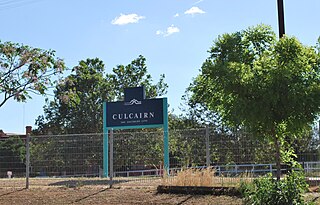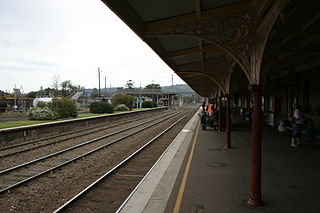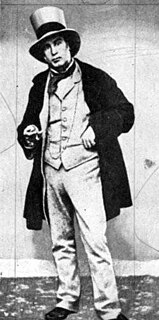
The Wagga Wagga railway station is an heritage-listed railway station and now museum and railway station located on the Main South line in Wagga Wagga, in the City of Wagga Wagga local government area of New South Wales, Australia. The station is also known as the Wagga Wagga Railway Station and yard group. The property is owned by RailCorp, an agency of the Government of New South Wales. The station was added to the New South Wales State Heritage Register on 2 April 1999.

Molong railway station is a heritage-listed former railway station and now library on the Main Western railway line at Molong, Cabonne Shire, New South Wales, Australia. The property is owned by RailCorp, an agency of the Government of New South Wales. It was added to the New South Wales State Heritage Register on 2 April 1999.

Culcairn railway station is located on the Main South line in New South Wales, Australia. It serves the town of Culcairn. It was added to the New South Wales State Heritage Register on 2 April 1999.

Cootamundra railway station is located on the Main South line in New South Wales, Australia. It serves the town of Cootamundra. The property is owned by RailCorp, an agency of the Government of New South Wales. It was added to the New South Wales State Heritage Register on 2 April 1999.

The Bomen railway station is an heritage-listed closed railway station located on the Main South line in Bomen in the City of Wagga Wagga local government area of New South Wales, Australia. The property is owned by RailCorp, an agency of the Government of New South Wales. The station was added to the New South Wales State Heritage Register on 2 April 1999. Passenger trains no longer stop at the station.

Galong is a closed railway station located on the Main South railway line in New South Wales, Australia. It served the village of Galong. It was added to the New South Wales State Heritage Register on 2 April 1999.

The Temora railway station is an heritage-listed former railway station and now youth hub and mixed-use building located on the Lake Cargelligo railway line in Temora in the Temora Shire local government area of New South Wales, Australia. The station was built from 1893 to 1915 and served the Riverina town of Temora between 1 September 1893 until its closure for passenger services in the late 1970s. The station is also known as the Temora Railway Station group. The property is owned by RailCorp, an agency of the Government of New South Wales. The station was added to the New South Wales State Heritage Register on 2 April 1999.

Casino railway station is located on the North Coast line in New South Wales, Australia. It serves the town of Casino, opening on 22 September 1930. It was added to the New South Wales State Heritage Register on 2 April 1999.

The Walcha Road railway station is an heritage-listed railway station located on the Main Northern line in Walcha Road, Walcha Shire, New South Wales, Australia. The railway station serves the village of Walcha Road and town of Walcha, opening on 2 August 1882 when the line was extended from Kootingal to Uralla. It is also known as Walcha Road Railway Station and yard group. The property is owned by RailCorp, an agency of the NSW Government. It was added to the New South Wales State Heritage Register on 2 April 1999.

Broken Hill railway station is a heritage-listed railway station located on the Broken Hill line in Broken Hill, New South Wales, Australia. It was added to the New South Wales State Heritage Register on 2 April 1999.

The Uralla railway station is an heritage-listed railway station located on the Main Northern line in the Uralla Shire, New South Wales, Australia. It serves the town of Uralla, and opened on 2 August 1882 when the line was extended from Kootingal. It was the terminus of the line until it was extended to Armidale on 3 February 1883. It is also known as Uralla Railway Station group. The property is owned by RailCorp, an agency of the Government of New South Wales. It was added to the New South Wales State Heritage Register on 2 April 1999.

Blayney railway station is a heritage-listed railway station on the Main Western line in Blayney, Blayney Shire, New South Wales, Australia. The property is owned by RailCorp, an agency of the Government of New South Wales. It was added to the New South Wales State Heritage Register on 2 April 1999.

The Murrurundi railway station is an heritage-listed railway station located on the Main Northern line in Murrurundi in the Upper Hunter Shire local government area of New South Wales, Australia. It was built between 1872 and 1917. It is also known as Murrurundi Railway Station group. The station serves the town of Murrurundi and opened on 4 April 1872. The station served as the terminus of the line until it was extended to Quirindi on 13 August 1877. The station is owned by RailCorp, an agency of the Government of New South Wales and was added to the New South Wales State Heritage Register on 2 April 1999.

The Tarana railway station is a heritage-listed former railway station located on the Main Western line in Tarana, City of Lithgow, New South Wales, Australia. It is also known as the Tarana Railway Station and yard group. The property is owned by RailCorp, an agency of the Government of New South Wales. It was added to the New South Wales State Heritage Register on 2 April 1999.
The Wallerawang railway station is a heritage-listed disused railway station located on the Main Western line in Wallerawang, City of Lithgow, New South Wales, Australia. It is also known as Wallerawang Railway Station and yard group. The property is owned by RailCorp, an agency of the Government of New South Wales. It was added to the New South Wales State Heritage Register on 2 April 1999.
Lismore railway station is a heritage-listed former station on the Murwillumbah line at Lismore, New South Wales, Australia. It was added to the New South Wales State Heritage Register on 2 April 1999.

Cobar railway station is a heritage-listed former railway station on the Cobar railway line at Cobar, Cobar Shire, New South Wales, Australia. The property is owned by RailCorp, an agency of the Government of New South Wales. It was added to the New South Wales State Heritage Register on 2 April 1999.

The Corowa Flour Mill is an heritage-listed former flour mill and now tourist attraction at Steel Street, Corowa, Federation Council, New South Wales, Australia. It is also known as the Corowa Flour Mill and site. It was added to the New South Wales State Heritage Register on 2 April 1999.

The Corowa Courthouse is an heritage-listed courthouse located at 8 Church Street, Corowa, in the Federation Council local government area, New South Wales, Australia. It was designed by James Barnet, the Colonial Architect, and built from 1886 to 1887 by W. Squires. It is also known as the Corowa Court House. The property is owned by the Department of Justice, an agency of the Government of New South Wales. It was added to the New South Wales State Heritage Register on 22 December 2000.



























